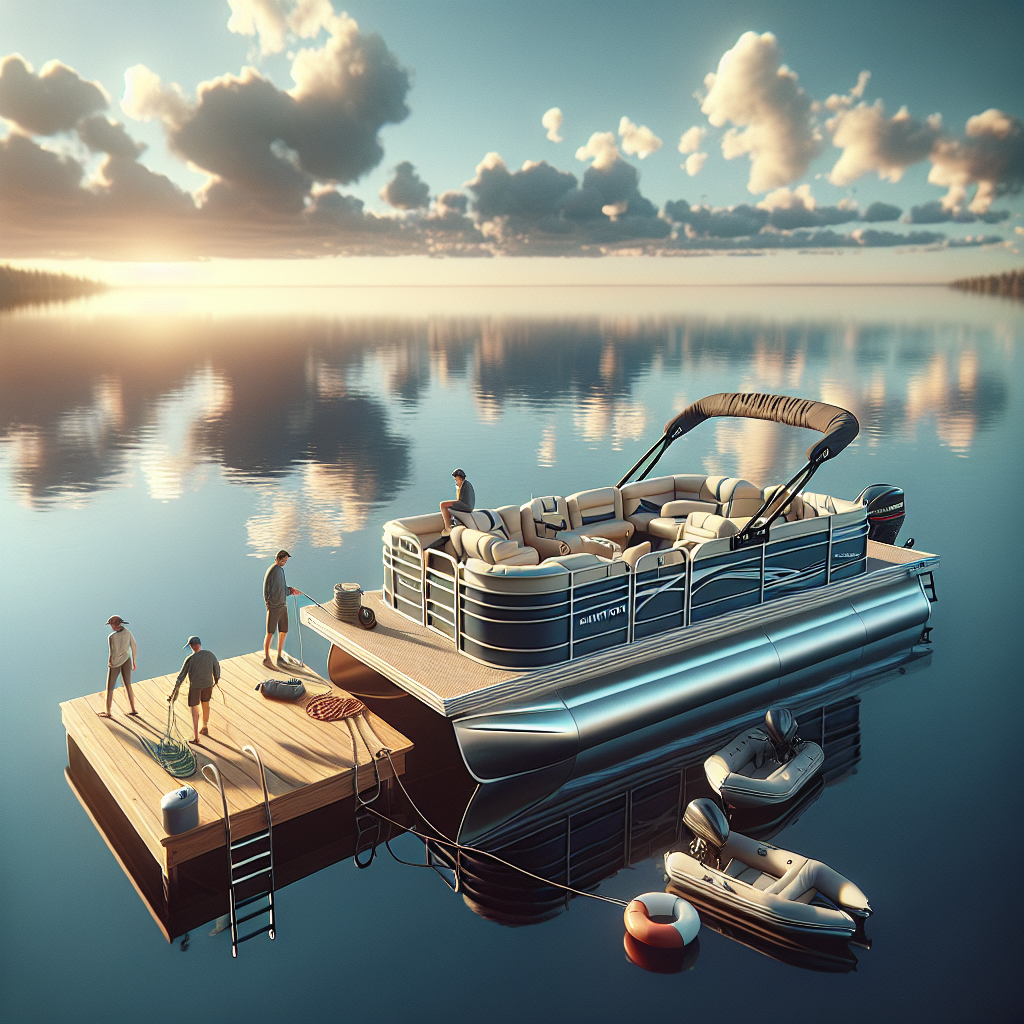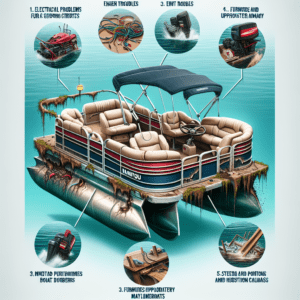Introduction to Manitou Pontoon Boats
Manitou pontoon boats are popular for their durability, speed, and comfort. These boats offer exceptional value for money, making them an attractive choice for boaters of all experience levels. This article provides an overview of the Manitou pontoon brand and explores the benefits of choosing this type of boat. Additionally, it shares some of the most common problems owners encounter with their Manitou pontoons and offers preventative maintenance strategies to avoid these issues.
The purpose of this article is to help Manitou pontoon owners enjoy their boats to the fullest by providing advice and insights that address common problems, enhance the riding experience, and inspire a community of enthusiasts.
Common Issues with Manitou Pontoon Boats
Pontoon boating is an excellent way to get out on the water and enjoy the beauty of nature. However, as with any type of boat, you may encounter some problems when using a Manitou pontoon boat. Knowing what difficulties you may face can help you oversee your vessel and keep it in top-notch condition.
Electrical Problems
One of the most common issues people face with Manitou pontoons is electrical problems. These problems may range from a dead battery to a blown fuse or something more significant. Electrical problems can lead to various issues, including the failure of your boat’s components, malfunctioned navigational devices, and instruments. To prevent these issues, you should regularly inspect and maintain your electrical system, including batteries, cables, and connections.
Engine Troubles
Having engine problems while you’re out on the water can be scary and frustrating. Some common engine problems with Manitou pontoons are overheating, stalling, and strange noises. To avoid engine troubles, you should periodically inspect your engine, including checking the oil, fuel filters, hoses, and belts.
Furniture and Upholstery Damage
Pontoon boat interiors are subject to wear and tear from sun exposure, water, and human handling. This damage may show up as mildew, fading, or even tearing of the seats and upholstery. Moreover, care should be taken on the floor surfaces of pontoon boats since they can become slippery when wet. To ensure your boat’s furniture and interior remain in excellent condition, clean them regularly, use high-quality materials, and store your boat in a covered area or shaded location.
Pontoons and Hull Concerns
Pontoons and the hull’s underside can experience damage if not addressed. In particular, excessive impact from debris and rocks can lead to punctures, cracks, or even complete damage. You can prevent pontoon and hull damage by remaining cautious when launching and docking your boat, staying clear of low water levels, and performing regular maintenance.
Steering and Navigation Challenges
Steering and navigation can present challenges to even the most experienced of boaters. These challenges include problems with your steering system, rudder, or outboard motor. To avoid such situations from happening, inspect your steering system, rudder or outboard motor regularly, and schedule maintenance as recommended by your manufacturer.
By knowing what the most common issues with Manitou pontoon boats are, you can take better care of your vessel and avoid unpleasant surprises while on the water. Regular inspection, maintenance, and proper use can help increase your boat’s lifespan, safety, and enjoyment.
Preventative Maintenance Strategies
The best way to avoid common issues with your Manitou pontoon boat is through preventative maintenance strategies. These strategies involve regular inspections and care, winterization and storage tips, engine maintenance, and electrical system upkeep. By following these strategies, you will be able to keep your boat in excellent condition for years to come.
A. Regular Inspection and Care
Regular inspection and care is essential to ensure your boat runs smoothly and efficiently. This involves checking the oil and filter, ensuring the battery is fully charged, and inspecting the electrical system for any signs of damage or wear. Remember to always follow the manufacturer’s instructions for the proper care and maintenance of your boat.
Table 1. Regular Inspection and Care Checklist
| Component | Inspection | Maintenance |
|---|---|---|
| Oil and filter | Check for proper levels and color | Change oil and filter as recommended by manufacturer |
| Battery | Check battery voltage and charge levels | Charge battery if needed |
| Electrical system | Inspect for any signs of damage or wear | Replace any damaged or worn components |
B. Winterization and Storage Tips
Winterization and storage tips are vital if you plan on storing your boat during the off-season. This involves draining the engine and water systems, removing the battery, and properly covering the boat to prevent damage from weather or pests. Following these tips will ensure your boat is ready to use when you are ready to hit the water again.
List 1. Winterization and Storage Tips
- Drain the water and engine systems
- Remove the battery and store it in a cool, dry place
- Clean and dry the boat thoroughly, and store it in a covered and protected area
C. Engine Maintenance
Proper engine maintenance is crucial to keep your boat running smoothly and efficiently. This involves regular oil changes, replacing the fuel filter, and inspecting the belts and hoses for any signs of wear or damage. By following the manufacturer’s recommendations, you can keep your engine running smoothly for years to come.
Quote 1. Importance of Engine Maintenance
“With proper engine maintenance, you can ensure your boat is always ready for action. By following the manufacturer’s recommendations, you can avoid costly repairs and keep your boat running smoothly and efficiently.”
D. Electrical System Upkeep
The electrical system is an essential part of your boat, and proper upkeep is vital to avoid any issues. This involves inspecting the wiring for any signs of damage, checking the fuses and circuit breakers, and ensuring the battery is fully charged. By following these simple steps, you can avoid common electrical problems and keep your boat running smoothly.
Table 2. Electrical System Upkeep Checklist
| Component | Inspection | Maintenance |
|---|---|---|
| Wiring | Inspect for any signs of damage or wear | Replace any damaged or worn wiring |
| Fuses and circuit breakers | Check for proper levels and functionality | Replace any faulty fuses or circuit breakers |
| Battery | Check battery voltage and charge levels | Charge battery if needed |
Troubleshooting and Repairs
A. DIY Fixes vs. Professional Repairs
When facing a problem with your Manitou pontoon boat, the first question that comes to mind is whether to fix it yourself or seek the help of a professional. For minor issues like changing a fuse or installing a new battery, DIY fixes can save you time and money. However, for more complicated issues like engine troubles or electrical system failures, it’s best to seek the help of a professional. Not only can they diagnose and fix the problem quickly, but they also have the equipment and expertise needed to get the job done right.
B. Identifying Common Manitou Pontoon Parts
Before you can fix a problem with your Manitou pontoon boat, you need to know what parts are causing the issue. Common parts that can cause problems include the engine, electrical system, pontoon tubes, upholstery, steering system, and hull. Familiarize yourself with these parts, and keep an eye on them during regular inspections. This way, you can catch problems early and prevent more significant issues from arising.
C. Step-by-Step Guides for Common Issues
For DIY enthusiasts, step-by-step guides can be an excellent resource for troubleshooting and repairing common issues. Some common problems with Manitou pontoon boats include electrical system failures, engine troubles, and pontoon tube damage. Look for guides specific to your issue, and follow the instructions carefully. Be sure to use the appropriate tools and safety equipment, and don’t hesitate to seek professional help if you’re unsure of what to do.
D. When to Seek Help from Manitou Dealers
If you’re facing a problem that you can’t fix on your own, it’s time to seek help from a Manitou dealer. These professionals are trained to diagnose and fix problems with Manitou pontoon boats quickly and efficiently. They have the necessary equipment, parts, and expertise needed to get your boat back in working order. If your boat is still under warranty, your dealer may even be able to fix the issue for free.
In conclusion, troubleshooting and repairing issues with your Manitou pontoon boat can be a daunting task. However, with the right resources and knowledge, you can quickly and effectively fix common problems. Remember to follow safety guidelines, use the right tools and equipment, and seek professional help when needed. By doing so, you can prolong the life of your Manitou pontoon boat and enjoy many summers on the water.
| Key Data Points | Details |
|---|---|
| A. DIY Fixes vs. Professional Repairs |
|
| B. Identifying Common Manitou Pontoon Parts |
|
| C. Step-by-Step Guides for Common Issues |
|
| D. When to Seek Help from Manitou Dealers |
|
Enhancing Your Manitou Pontoon Experience
Once you have familiarized yourself with the common problems and maintenance procedures for your Manitou pontoon boat, you may want to consider upgrading or customizing your vessel to enhance your overall experience on the water. Here are some ideas:
A. Upgrades and Customizations
- Audio System: Add a high-quality audio system to your pontoon boat to enjoy your favorite music while cruising. This includes new speakers, subwoofers, and amplifiers.
- Lights: Illuminate your pontoon boat with LED lights for an enhanced night time experience on the water. You can also add underwater lights to create a stunning light show.
- Tower: Add a tower to your pontoon boat to transform it into a wakeboarding and waterskiing machine. Towers can be easily installed and allow you to attach ropes and towables.
- Seating: Upgrade your pontoon boat seating with new materials or designs to make it more comfortable and stylish. You can also add more seats to accommodate more passengers.
B. Resources and Support for Manitou Owners
Manitou Pontoon Boats offer a range of resources and support for their customers to ensure an enjoyable ownership experience. This includes:
- Online Manuals: Access Manitou’s online manuals to learn more about your pontoon boat, its parts, and maintenance procedures.
- Customer Service: Contact Manitou’s customer service team for assistance with troubleshooting, repairs, and replacement parts.
- Community: Joining online communities of Manitou pontoon boat owners is an excellent way to find helpful tips, advice, and connect with fellow boaters.
C. Joining Manitou Pontoon Communities
Joining an online community of Manitou pontoon boat owners is an excellent way to stay up-to-date on the latest news, tips, and advice. Facebook groups and forums such as Manitou Pontoon Owners and Pontoon Forum provide a platform for users to share their experiences, ask questions, and connect with other boaters.
D. Final Thoughts on Long-Term Manitou Pontoon Enjoyment
Enjoying your Manitou pontoon boat for years to come requires regular maintenance, preventative care, and occasional upgrades. With the right approach, you can ensure your pontoon boat remains in top condition and provides countless hours of enjoyment on the water. Remember to always prioritize safety and have fun!
Frequently Asked Questions (FAQs)
Q: How can I prevent electrical problems in my Manitou pontoon boat?
A: Regularly inspect your electrical system components and connections. Avoid overloading the system and be gentle when plugging and unplugging electrical devices.
Q: How often should I winterize my Manitou pontoon boat?
A: It’s recommended to winterize your pontoon boat once a year before storing it for the off-season.
Q: Do I need professional help to fix common pontoon boat issues?
A: It depends on the severity and complexity of the problem. Many routine issues can be tackled with DIY fixes, while more significant problems may require professional help.
Q: What is the best way to store my Manitou pontoon boat during the off-season?
A: Store your pontoon boat in a dry, covered area away from the elements. This can include a garage, carport, or specially-constructed boat shelter.







